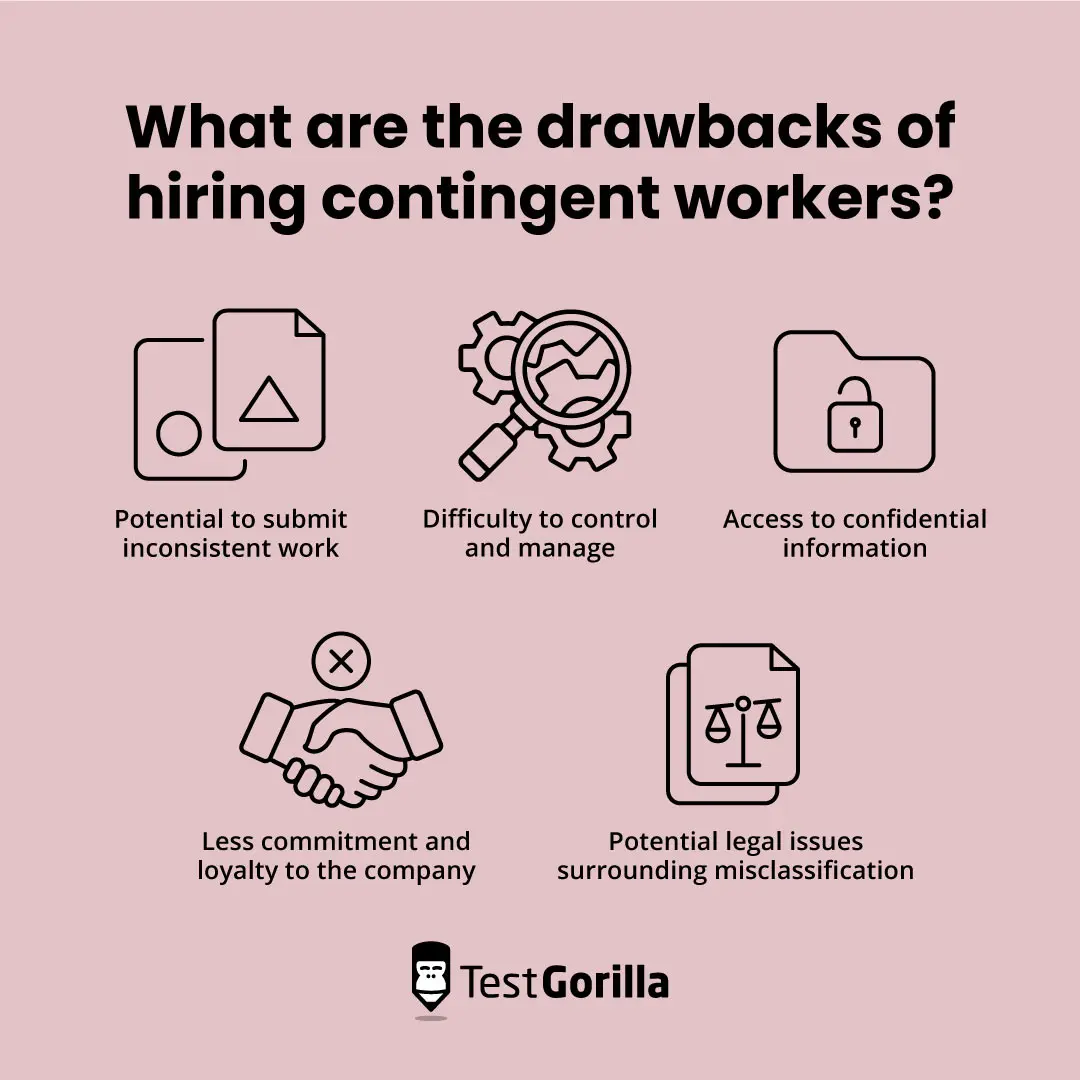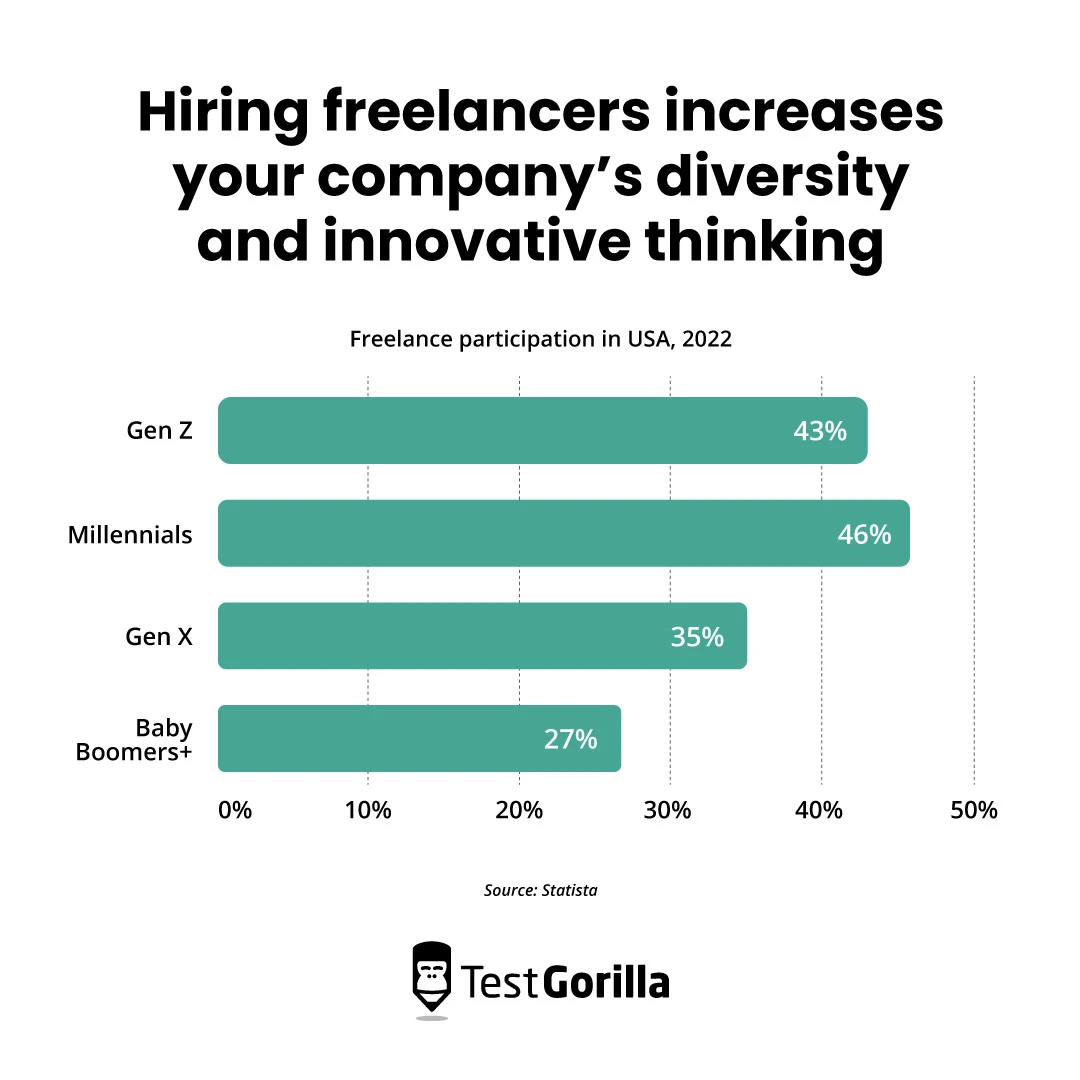Contingent workers: How to leverage this talent acquisition trend and benefit from a new workforce
Hiring full-time employees is always the best course of action…isn’t it?
It’s traditional, it’s conventional – but then business gets a little slow, and you notice they’re on YouTube all the time.
So then how do you hire for sudden growth or busier periods?
The contingent workforce has exploded with the rise of companies like Upwork and Fiverr. It isn’t just a small pool of graphic designers and consultants that freelance anymore.
Some experts estimate more than 52 million contingent workers exist in the US alone.[1]
You’re missing out on great talent if you aren’t opening your doors to contingent workers.
Hiring contingent workers is one of the top talent acquisition trends in HR. These candidates enable you to recruit niche talent fast, reduce costs, and increase innovation.
This blog talks about the importance and benefits of hiring contingent workers. It also includes a list of best practices to build a bulletproof process.
Feel free to skip ahead to the tips if you’re in a hurry.
Table of contents
- What is a contingent worker?
- Why is a contingent workforce important?
- The benefits of hiring contingent workers
- 7 best practices for leveraging contingent workers to acquire top talent
- Contingent workers: 3 examples of companies succeeding with this talent acquisition trend
- Use skills tests to hire contingent workers with confidence
What is a contingent worker?
A contingent worker is an individual working for an organization without being hired as an employee.
Typically, you hire contingent workers for a specific time or project.
Contingent workers have been around for ages, but the trend gained traction around 2017 in areas with high living costs. Many people had to adopt part-time work and “side hustles” in the gig economy to pay the bills.
They’re now a common addition to talent acquisition strategies. Countless companies leverage a few of these workers alongside traditional employees, and some organizations have a complete contingent workforce.
Contingent workers vs. traditional employees
What are contingent workers compared with permanent employees? Here’s a quick side-by-side look:
Contingent workers | Traditional employees |
Are responsible for their own taxes | The business owner withholds income for taxes |
Receive no benefits, and generally add 10% to their price tag to account for this | The company offers benefits and pension |
Provide direction and motivation to themselves without direct guidance from management | Rely on managers and supervisors for direction and guidance |
Don’t usually require training, only project-specific instructions | Require onboarding and training |
Have more control over when, how, and where they do their work | Have to follow company policies on where and how they do their work |
Negotiate their pay rate | Receive a fixed salary |
It’s important to note the differences for several reasons:
Knowing your needs during strategic workforce planning
Determining how to fill skills gaps
Reviewing legal matters, employment law, payroll taxes, and preventing misclassification
That last point is important because misclassification can cause companies many unnecessary headaches. We look at that in more detail later.
Types of contingent workers
The contingent workforce is a broad umbrella and encompasses different professionals.
Here are the most common examples of contingent workers:
Free agents
Freelancers
Self-employed consultants
Contractors or contract workers
Temporary workers
Outsourced employees
Part-time workers
These terms are different, although some of them are interchangeable. You could find contingent laborers who consider themselves contractors and freelancers.
Why is a contingent workforce important?
Why do companies hire contingent workers?
Hiring contingent workers has always been an option in many industries, but it’s recently exploded to nearly every role, making the practice more approachable than ever.
Like nearly every practice, demand pushed it into the limelight. Between 2016 and 2018, the cost of living in the US soared higher than it had been in years.[2]
Full-time wages weren’t cutting it anymore, and these workers had to take up contingent work to make ends meet, working a few hours a week for companies like Uber or DoorDash.
It’s also linked to the Great Resignation of 2021. Many professionals, especially those with niche skills, opted to leave their employers and become their own bosses, which enabled them to market their skills at a higher price.
Let’s go a little more deeply into why a contingent workforce is important to employers:
Access to a wide talent pool: Hiring contingent workers helps you fill your talent pipeline with people worldwide. It also opens the door for workers who only freelance and workers who have traditional jobs but also work as independent contractors as a side hustle.
Access specialized skills: Many contingent workers possess niche skills so they can quickly and efficiently fill high-priority roles, like cybersecurity positions.
Adaptable, dynamic workforce: Managing contingent workers enables you to adjust your workforce quickly and dynamically, helping you scale or downsize easily.
The advantages of contingent workers also spread to the workers themselves.
Many contingent workers love having greater autonomy. It gives them control over their work, prevents micromanaging, and helps them adjust their job to their schedules. People with many responsibilities, like working parents, find it particularly important.
The contingent workforce also generally works fewer hours and charges a higher rate, helping them take on more clients and set money aside for taxes.
The benefits of hiring contingent workers
From reduced costs to reduced time-to-hire, there are powerful benefits to hiring all types of contingent workers.
Of course, it has its challenges and drawbacks, but no hiring practice is perfect.
The main drawbacks of hiring contingent workers are:
Potential to submit inconsistent work
Difficulty to control and manage
Security risks because of access to confidential information
Less commitment and loyalty to the company
Potential legal issues surrounding misclassification
However, the advantages of hiring contingent workers far outweigh the challenges.
Here’s an in-depth look at them.
Quickly fill skills gaps
Filling skills gaps is essential for every company. Skills make a business run, but it isn’t always obvious which skill sets you lack.
Conducting a skills gap analysis helps you determine which skills you need quickly, and hiring contingent workers helps you bridge those gaps just as fast.
A contingent workforce offers a quick fix to major skills gaps. This strategy may be temporary, like filling a role until you can find a full-time hire or finish upskilling employees.
But you may also decide to keep the contingent worker in that role for the foreseeable future. You could even decide to extend an offer of full-time work to them.
Let’s discuss that next.
Trial new positions
Does your hiring plan include a full-time role you aren’t quite ready to fill? Trial the position with contingent workers until you’re ready to decide.
Trialing helps you ensure the position is needed and beneficial to your organization. It also helps you decide if a worker is a good fit.
After some time, you could decide to offer contingent workers positions as permanent workers in the company.
The process sets you up for a quality employee because you already know the worker’s skills, work style, and temperament.
You’ve also built a relationship with the non-employee and know useful details about them, such as their certifications.
Hiring a contingent worker into a permanent role boosts retention, decreases turnover, and prevents mis-hires.
Save time
Sometimes, the need to fill a role is urgent – but filling an open role via traditional hiring takes an average of 11 weeks.
Hiring contingent workers is faster and requires less red tape than hiring full-time workers.
With employees hired on a permanent basis, it’s usually a lengthy process of sourcing, hiring, onboarding, and training – and we’re not even accounting for setting up taxes and benefits like health insurance.
Contingent workers are faster to source and hire, don’t usually require training, don’t receive a traditional employee benefits package, and do their own taxes. There’s also the benefit that many independent contractors and freelancers can start immediately, not weeks or months from now.
A wide talent pool also reduces time-to-hire. The vast contingent workforce combined with the ease of hiring means that you can source and hire in days rather than weeks or months.
Reduce costs
One of the major benefits of hiring contingent workers is the cost.
A contingent workforce is dynamic and generally project-based. You can react with a flexible, adaptable workforce if business expenses and profits fluctuate.
When you hire talent as needed for a specific project, you only pay for the services you need instead of a continuous salary.
For example, if you don’t need design work regularly, an onsite designer could be an expense you can’t afford. Hiring a graphic designer on a project-to-project basis is much more efficient.
It’s also beneficial to your budget that you pay the rate for their work but not for traditional compensation and benefits. After all, they are their own business.
Benefit from unique perspectives
When you hire freelancers and independent workers, you gain diverse candidates with perspectives outside your organization’s typical processes, increasing your company’s diversity and innovative thinking.
For instance, 43% of Gen Z, 46% of Millennials, and 35% of Gen X chose a freelance route.
Hiring Gen Z candidates, nearly half of whom are contingent workers, brings a new generation of thoughts and perspectives to your company.
But the other generations are important to consider, too.
Hiring millennials and Gen X candidates leads to greater generational diversity.
One of the biggest benefits of diversity is the increased creativity from a broad range of opinions. Hiring contingent workers boosts diversity in many ways, including age, gender, ethnicity, and race.
7 best practices for leveraging contingent workers to acquire top talent
Contingent workers are here to stay in this agile, dynamic world.
But we need keen tactics to get the most out of this dynamic workforce.
Let’s look through our top best practices for hiring and managing contingent workers.
Strategies for hiring the best contingent workers: A summary
Strategies | Description |
1. Review each applicant’s work | Look over a contingent worker’s portfolio and check for relevant skills |
2. Assess contingent worker skills with talent assessments | Gauge capabilities objectively by relying on accurate skills tests |
3. Gauge language proficiency so you can hire international talent | Stop requiring “native language speakers only” Evaluate language ability through talent assessments |
4. Hire a professional to handle all legal matters | Get a professional to write up contingent worker policies and manage legal concerns |
5. Develop a structured payment process | Build a reliable payment process to enhance your reputation |
6. Implement flexibility to better support your contingent workforce | Adopt a flexible work policy for your contingent workers and full-time staff |
7. Use niche job boards to find specialists | Explore industry-specific job boards to locate high-quality talent |
1. Review each applicant’s work
The best way to start reviewing a contingent worker’s talent is through their portfolio.
Reviewing portfolios is a reliable, skills-focused method to determine if the worker has your desired qualities.
You can also read testimonials from previous clients if a contingent worker has them.
What should you look for when reviewing a contingent worker? Keep an eye out for these broad points:
Their specialization and niche-specific skills
Roles they’ve played in group projects
Testimonials that support the applicant’s claims, especially soft skills like communication
Up-to-date content
Concise information on results and objectives reached
Keep in mind any specific qualities that are important for the open position. For example, you could be hiring a writer for a lifestyle website, so it’s great to see a candidate with a portfolio filled with lifestyle content examples.
Reviewing portfolios is a normal practice when hiring contingent workers, and it also happens to be more effective than traditional methods.
Going through a tangible portfolio of real examples tells you far more than a list of skills on a resume.
As for the next step? After you’re done looking through portfolios, send your chosen candidates a talent assessment.
2. Assess contingent worker skills with talent assessments
Contingent worker skills are tough to verify in the same way as traditional employees.
Education and experience may be scarce or non-existent because many contingent workers do what they do as a side hustle. These workers also may not have readily available references.
We believe traditional methods are difficult because you shouldn’t use them to evaluate the contingent workforce.
Even assessing a full-time employee based on years of experience and college degrees isn’t completely reliable. They are not the best way to gauge contingent workers either.
How do you determine contingent talent? Evaluate candidates with talent assessment tests.
Talent assessments gauge a candidate on objective skills and behavioral competencies, giving you accurate results and them a fair chance at a great role.
Here’s a quick step-by-step on how to evaluate a worker with skills tests:
Send applicants skills tests
Get the results back after they complete them
Sort the results by test score according to your own benchmarks
Invite the highest-scoring candidates to interviews
Data driven recruiting like this is the most effective, efficient way to hire a contingent worker. It bypasses unreliable methods like resumes and reduces unconscious bias that can arise when a worker doesn’t have the “right” degree or work history.
If you’d like to read more on this topic, check out our article on using skills-based hiring to effectively hire contingent workers.
Another bonus of using talent assessments is that you can store unsuccessful candidates in a handy database for future passive recruiting.
3. Gauge language proficiency so you can hire international talent
You miss out on great candidates when you don’t extend your reach beyond your own region or country.
Many companies ask candidates to be native speakers, especially in language-heavy roles like writing and editing, which is problematic in a few ways.
Requiring candidates to speak a language natively narrows your talent pool and denies great candidates a chance at your position. It’s illegal in some regions, although many companies still do it.
We recommend adding the level of language proficiency the role requires to your job description and then determining a candidate’s fluency with language tests.
Language tests enable you to quickly and efficiently assess language skills so you can access the massive amount of contingent workers from different parts of the world.
Revolut, a financial services company, used to gauge language proficiency manually, which involved reviewing written assignments and conducting in-person verbal assessments.
After it switched to online language tests, the power of recruiting automation reduced its time-to-hire by 40%.
This process helps you keep your talent pool wide and ensures you get qualified candidates with the language skills you need.
4. Hire a professional to handle all legal matters
The contingent workforce is an important strategy to keep in your back pocket, but you need to consider the laws surrounding it.
One of the main legal concerns when hiring contingent workers is misclassification.
This error happens when a company classifies a person as a contingent worker when they're an employee.
In this case, the employer can be liable for unpaid taxes, benefits, and back pay, depending on the local laws.
We recommend hiring a professional for this. Ensure you have all legal matters organized and double-checked by an attorney or other legal worker.
This person can also help you determine your contingent working policies because it’s also a legal concern if you try to control or micromanage the contingent worker too intensely.
Disclaimer: The information contained on this site is provided for informational purposes only and is not legal advice on any subject matter. Please consult a lawyer if you have any questions on contingent worker policies in your area.
5. Develop a structured payment process
One of the top contingent workforce management best practices is developing a structured, effective payment process.
Determine your payment structure in advance. Do you have a payroll specialist lined up who can handle contingent workers? Do you have a company account on a major payments site?
We also recommend supporting different payment methods to facilitate paying different people to open your talent pool further.
You wouldn’t want to reject a candidate solely because they live in a country that doesn’t support a particular payment processor, like Wise or PayPal.
Clear and structured payment is an important aspect of hiring and directly impacts your employer branding.
Personalized, quick, and efficient payment creates a lasting mark on freelancers. Having contingent workers talk about sluggish or incorrect payments harms your reputation and brand image.
6. Implement flexibility to better support your contingent workforce
A key part of managing contingent workers is facilitating their flexibility.
If you’re hiring from different regions and countries, supporting these people in different time zones is much easier if you have established flexible working policies.
We don’t recommend creating one once you secure your first contingent hire. It’s important to establish flexible work practices in advance for several reasons:
It gives you time to get used to it
It gives you time to perfect your processes
It enables your current employees to benefit from flexible work first
Facilitating remote employees helps reduce possible resentment.
For example, it could be demotivating for your employees if a contingent graphic designer comes in now and then, talks about finishing their work at the local cafe, and then takes off – meanwhile, everyone else has to remain in the office.
Establishing flexibility in the workplace for everyone boosts equality, fairness, and inclusivity. A flexible work policy is also important because many contingent workers need autonomy.
Depending on the worker, you can lay some ground rules for core hours or days but remain flexible.
7. Use niche job boards to find specialists
You can’t find everything you need on one generic platform when searching for specialist skills.
We recommend looking for niche job boards. Posting job ads on industry-specific platforms helps catch the eye of the right people.
You can also use these websites to conduct specific searches if you’d like to connect directly with professionals.
Here are a few specialist job boards sorted by industry:
Creatives | Tech workers | Construction and plumbing |
Creatively Behance Voices | Built In Dice Tech Ladies | ConstructionJobs iHireConstruction RoadTechs |
This practice connects you to niche specialists who are highly skilled in their fields. But it’s more than that: It also enables you to boost your inclusive hiring.
For example, Tech Ladies isn’t just a niche tech job board. It’s also a community for supporting women, trans people, and non-binary folks.
The platform helps you boost your female and LGBTQ+ inclusion in the workplace and build a good company culture.
Contingent workers: 3 examples of companies succeeding with this talent acquisition trend
Let’s look at a few companies leveraging a contingent workforce and thriving.
Organizations hiring contingent workers successfully: A summary
Companies | Description |
Robert Half | Provides contingent workers with a great candidate experience |
Apple | Helps contingent workers grow and learn |
Bridges skills gaps with a large contingent workforce |
Robert Half
Robert Half, a major human resources consulting firm, is well-known for hiring contingent workers alongside its usual employees.
The team makes it a positive candidate experience, and freelancers are eager to land a gig.
It even offers its contingent workers a small selection of benefits, although it doesn’t publicly disclose them.
These workers are also eager to spread the company’s employer branding.
Freelancers who work with the organization say the experience is flexible, friendly, fun, and well-paid. Many compliment the great management style and are grateful for consistent projects.[3]
Apple
Apple has a large and prosperous on-demand freelancer workforce.
Many contingent workers cite the company as an important stepping stone for career growth, offering valuable learning and development opportunities and experience.
People freelancing for the smartphone leader speak highly about the:
Diversity
Flexibility
Good pay
Good management
Like our previous example, the company also supports contingent workers with a handful of freelancer-only benefits.
The company’s contingent workforce is amazing for its reputation and employer branding.
Apple’s freelancer page on Glassdoor has stellar reviews like:
"Truly organized and helpful. I was able to grow there." [4]
Google doesn’t just supplement its workforce with contingent workers – instead, it relies on them.
At one point, it had more freelancers than full-time employees: 120,000 versus 102,000.[5]
The company has stated it has many reasons for hiring contingent workers, including filling in for employees on leave, addressing short-term spikes in workload, and providing expertise it doesn’t have in-house.
The temporary employees have nothing but praise for the search engine giant. Freelancers say the business is team-oriented, has great management, and helps you grow and learn through problem solving.[6]
Contingent workers also praise Google’s respect for their time and their work arrangements' high levels of trust and autonomy.[7]
Giving your contingent workforce a work environment filled with flexibility and autonomy is an expected perk – but it still leads to glowing brand reviews.
Use skills tests to hire contingent workers with confidence
The contingent workforce is a broad talent pool filled with niche skills and diverse perspectives.
It’s a talent acquisition trend that’s only gaining popularity and is here to stay.
You can overcome the challenges of hiring contingent workers by leveraging talent acquisition technology like skills tests.
These tests verify their skills, competencies, and capabilities without involving a resume and also help gauge language proficiency to tap into international markets. For more information on this topic, read our blog on recruiting internationally.
If you’d like to check out more than 300 talent assessments, browse our test library.
Sources
Kane, Jessica. (July 13, 2022). "Why Employers That Neglect The Contingent Worker Experience Risk Losing The War For Talent". Forbes. Retrieved August 23, 2023. https://www.forbes.com/sites/forbeshumanresourcescouncil/2022/07/13/why-employers-that-neglect-the-contingent-worker-experience-risk-losing-the-war-for-talent/
"Cost of Living Index by Country 2017". Numbeo. Retrieved August 23, 2023. https://www.numbeo.com/cost-of-living/rankings_by_country.jsp
"Robert Half Freelancer Reviews". Glassdoor. Retrieved August 23, 2023. https://www.glassdoor.com/Reviews/Robert-Half-Freelancer-Reviews-EI_IE1838.0,11_KO12,22.htm
"Apple Freelancer Reviews". Glassdoor. Retrieved August 23, 2023. https://www.glassdoor.com/Reviews/Apple-freelance-Reviews-EI_IE1138.0,5_KO6,15.htm
"Google Has More Freelancers Than Full-Time Employees". Allwork. Retrieved August 23, 2023. https://www.allworknow.com/google-has-more-freelancers-than-full-time-employees/
"Google Employee Reviews for Freelancer". Indeed. Retrieved August 23, 2023. https://www.indeed.com/cmp/Google/reviews?fjobtitle=Freelancer
"Google Freelancer Reviews". Glassdoor. Retrieved August 23, 2023. https://www.glassdoor.com/Reviews/Google-Freelancer-Reviews-EI_IE9079.0,6_KO7,17.htm
Related posts
Hire the best candidates with TestGorilla
Create pre-employment assessments in minutes to screen candidates, save time, and hire the best talent.
Latest posts
The best advice in pre-employment testing, in your inbox.
No spam. Unsubscribe at any time.

Hire the best. No bias. No stress.
Our screening tests identify the best candidates and make your hiring decisions faster, easier, and bias-free.
Free resources
This checklist covers key features you should look for when choosing a skills testing platform
This resource will help you develop an onboarding checklist for new hires.
How to assess your candidates' attention to detail.
Learn how to get human resources certified through HRCI or SHRM.
Learn how you can improve the level of talent at your company.
Learn how CapitalT reduced hiring bias with online skills assessments.
Learn how to make the resume process more efficient and more effective.
Improve your hiring strategy with these 7 critical recruitment metrics.
Learn how Sukhi decreased time spent reviewing resumes by 83%!
Hire more efficiently with these hacks that 99% of recruiters aren't using.
Make a business case for diversity and inclusion initiatives with this data.



















